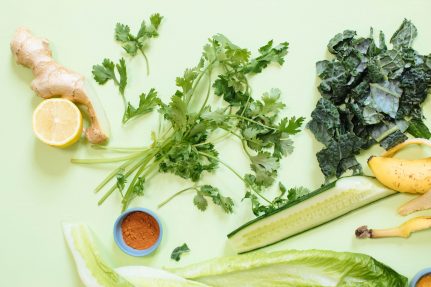Dietitian Nutritionist McKel explains what is the low FODMAP diet, the research behind FODMAPs and, who might benefit from following it.
For some people, the low FODMAP diet is less about weight loss and more about feeling better.
If you’ve ever discussed digestion problems with your doctor—or more specifically, symptoms of irritable bowel syndrome (or IBS)—then you might have heard of the low FODMAP diet. Created to help those with gastrointestinal sensitivities, this diet restricts certain foods in order to help alleviate problems like bloat, gas, and general abdominal discomfort.
What is IBS and How Does a Low FODMAP Diet Help Sufferers?
Irritable bowel syndrome is a very common problem in the U.S. In fact, about 10% to 15% of the population suffers from symptoms ranging from constipation, diarrhea, abdominal bloating and abdominal pain, according to the American College of Gastroenterology (1).
The catch is that not many people see their doctor with these issues let alone seek the help of dietitians — only about one in four will talk to an expert (1), and that’s likely because the syndrome won’t cause serious health problems. However, it does affect the quality of life, which is why it’s important to address any digestion issues, and why a doctor might suggest the low FODMAP diet.
Developed by researchers at Monash University, the low FODMAP diet is meant to help people with IBS feel better. Now to learn what exactly FODMAP means, let’s examine the basics of the diet.
What Exactly Is the Low FODMAP Diet?
In general, a FODMAP is a collection of naturally-occurring short-chain carbohydrates or sugars (only one or two sugars linked together), which the gut has trouble digesting in some people (2). FODMAP itself stands for Fermentable, Oligosaccharides, Disaccharides, Monosaccharides, and Polyols — all things people following the diet would aim to avoid.
Low FODMAP-Friendly Foods v. Foods High in FODMAPs
Let’s go over what the letters of FODMAP stand for and the foods that fit and don’t fit the diet (7):
- F stands for fermentable and refers to undigestable carbohydrates producing gas. It’s a more general overview of symptom-causing foods.
- O, for oligosaccharides, includes fructans and GOs, and foods like wheat, rye, onions, garlic and legumes or lentils.
- D for disaccharides particularly means lactose, so those following this diet should avoid milk, yogurt, and soft cheeses.
- M for monosaccharides pertains to fructose, often found in apples, honey, and high fructose corn syrup.
- P for polyols includes sorbitol and mannitol, which are often found in some fruits (like peaches, plums, or cherries), veggies (like mushrooms) and artificial sweeteners.
What Not To Eat On a FODMAP Diet
To break down the foods further, here’s what you shouldn’t eat on the low FODMAP diet, besides what’s mentioned above (9):
- Fruits: apricots, blackberries, boysenberries, cherries, canned fruit, dates, figs, pears, peaches, watermelon
- Vegetables: artichokes, asparagus, broccoli, beetroot, Brussels sprouts, cabbage, cauliflower, fennel, leeks, mushrooms, okra, peas, shallots
- Legumes: beans, chickpeas, lentils, red kidney beans, baked beans, soybeans
- Wheat: bread, pasta, most breakfast cereals, tortillas, waffles, pancakes, crackers, biscuits
For a full list of high FODMAP and low FODMAP foods, you can also download the Monash University app, which is a great resource that allows you to search for foods before you buy them!
FODMAP Friendly Foods
As for what’s OK to eat on the low FODMAP diet, here are foods you can still keep in your meal plan (9):
- All meats, fish, poultry, oils, herbs, and spices
- Nuts and seeds (except pistachios)
- Fruits: bananas, blueberries, cantaloupe, grapefruit, grapes, kiwi, lemons, lime, mandarins, oranges, passionfruit, raspberries, strawberries
- Dairy: lactose-free dairy products and hard cheeses
- Vegetables: alfalfa, bell peppers, bok choy, carrots, celery, cucumbers, eggplant, ginger, green beans, kale, lettuce, chives, olives, parsnips, potatoes, radishes, spinach, squash, sweet potatoes, tomatoes, turnips, yams, water chestnuts, zucchini
- Grains: Corn, oats, rice, quinoa, tapioca
How FODMAPs Affect Digestion
In terms of how FODMAPs might cause discomfort, it all comes down to how these foods move through the digestive system. For starters, FODMAPs cause the uptick of symptoms in IBS sufferers because they tend to bring excess water into the intestine (2). As a result, when these foods reach the large intestine, the bacteria in the gut can cause fermentation and release hydrogen gas, which then leads to flatulence, bloating, discomfort and other symptoms.
Several studies show the benefits of a low FODMAP diet for those with IBS (4)(5)(6). Some research (6) even supports the idea that it should be the first-line of therapy for IBS sufferers, meaning the initial attempt at controlling symptoms. (This explains why you might have heard of this diet from your doctor if you’ve mentioned symptoms of IBS.) When IBS sufferers avoid these foods, they avoid the slow digestion that causes uncomfortable symptoms.
How to Follow the Low FODMAP Diet
Typically, someone following the low FODMAP diet will work with a dietitian to strictly reduce the foods containing high amounts of FODMAPs for two to six weeks. Then, the patient would slowly re-introduce foods to see how the GI tract reacts and pinpoint certain trigger foods. Lastly, to make this a more sustainable diet, the patient would follow the more personalized low FODMAP plan. As a result, that means restricting trigger foods, so that he or she can still consume a diverse range of foods (3).
It’s best to work with a professional to follow this diet properly, especially to get through the elimination portion and then figure out how to add foods back in. For help, sign up for a nutrition coaching session with me. We can chat about whether this diet is a good fit and how to execute it properly.
The Downsides to a Low FODMAP Diet
One study mentions the disadvantages of the low FODMAP diet (8). According to research, there are benefits to following the diet strictly, but the studies lack information on what happens after that initial phase. (Another study (5) also mentions that although the evidence supports a low FODMAP diet reducing IBS symptoms, researchers still need to look at long-term effects of following such a strict food plan.)
Additionally, researchers call out the dangers of a restrictive diet in that it may lead to some nutrient deficiencies and increase the risk of disordered eating. Most importantly, that explains why it’s important to work with a professional to follow the diet closely and learn to add foods back in when appropriate.
The Bottom Line
If you have IBS, the low FODMAP diet may help you alleviate symptoms, which means it’s worthwhile to talk to your doctor and a dietitian who specializes in digestive health about it. Longterm, the diet might not be your best bet, because it’s so strict and you want to maintain diversity in your diet. Following the diet along with a professional, though, will help you pinpoint the exact foods that irritate your digestion! As always, we’re always here to help if you need 1-1 coaching just contact us!
Have you tried the low FODMAP diet for your digestive issues? If so, please share your story with the community, I’m sure there are others just like you who would love to hear your help, advice, and get support!
References
- Irritable Bowel Syndrome: Basics. American College of Gastroenterology.
- FODMAPs and Irritable Bowel Syndrome. Monash University.
- K. Whelan, L.D. Martin, H.M. Staudacher, M.C.E. Lomer. (2018, January). The low FODMAP diet in the management of irritable bowel syndrome: an evidence‐based review of FODMAP restriction, reintroduction and personalisation in clinical practice.
- Péter Varjú, Nelli Farkas, Péter Hegyi, András Garami, Imre Szabó, Anita Illés, Margit Solymár, Áron Vincze, Márta Balaskó, Gabriella Pár, Judit Bajor, Ákos Szűcs, Orsolya Huszár, Dániel Pécsi, József Czimmer. (2017, August). Low fermentable oligosaccharides, disaccharides, monosaccharides and polyols (FODMAP) diet improves symptoms in adults suffering from irritable bowel syndrome (IBS) compared to standard IBS diet: A meta-analysis of clinical studies.
- Wathsala S Nanayakkara, Paula ML Skidmore, Leigh O’Brien, Tim J Wilkinson, and Richard B Gearry. (2017, June). Efficacy of the low FODMAP diet for treating irritable bowel syndrome: the evidence to date.
- Peter R. Gibson. (2016, November). The evidence base for efficacy of the low FODMAP diet in irritable bowel syndrome: is it ready for prime time as a first-line therapy?
- High and Low FODMAP Foods. Monash University.
- Peta Hill, Jane G. Muir, PhD, and Peter R. Gibson, MD. (2017, January). Controversies and Recent Developments of the Low-FODMAP Diet.
- “FODMAP 101: A Detailed Beginner’s Guide.” Healthline.com.













